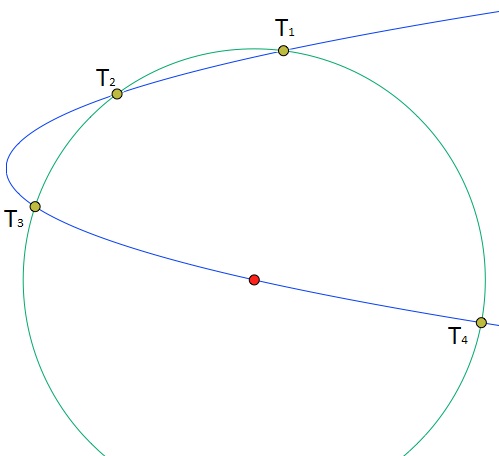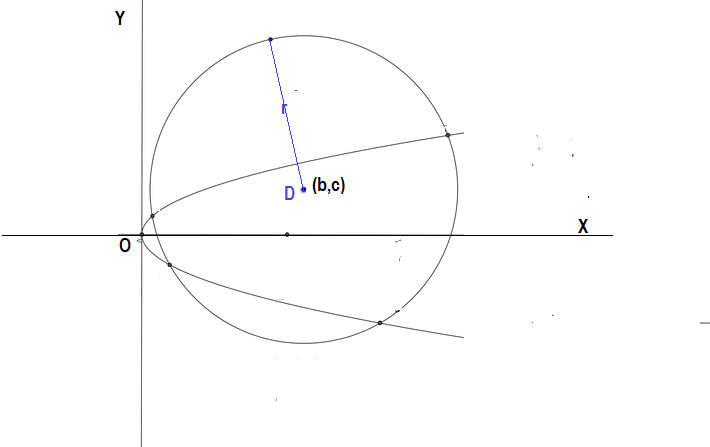As the parametric form of equation of parabola #y^2=4ax# is #(at^2,2at)# all the points #(at_i^2,2at_i)# for #i=1,2,3,4.# too lie on the parabola.
As they are points of intersection of parabola and circle, they also fall on the circle i.e. #(at_i^2,2at_i)# for #i=1,2,3,4.# lie on circle. Let these points be #T_1,T_2,T_3,T_4# respectively in cyclical order, as shown in the figure below.
Now #T_1T_2T_3T_4# is a cyclical quadrilateral and hence
#m/_T_2T_1T_4+m/_T_2T_3T_4=180^@# and #tanT_1=-tanT_3#(A)
To find #m/_T_2T_1T_4#, let us find the slopes of #T_2T_1# and #T_2T_4#.
Slope of #T_2T_1#, joining #(at_2^2,2at_2)# and #(at_1^2,2at_1)# is
#(2a(t_2-t_1))/(a(t_2^2-t_1^2))=2/(t_2+t_1)#
and similarly slope of #T_1T_4#, joining #(at_1^2,2at_1)# and #(at_4^2,2at_4)# is
#(2a(t_1-t_4))/(a(t_1^2-t_4^2))=2/(t_1+t_4)#
Now as measure of angle between two lines with slope #m_1# and #m_2# is #tan^(-1)((m_1-m_2)/(1+m_1m_2))#, we have
#tanT_1=(2/(t_2+t_1)-2/(t_1+t_4))/((1+(2/(t_2+t_1))xx(2/(t_1+t_4)))#
= #(2(t_1+t_4-t_2-t_1))/((t_1+t_4)(t_2+t_1)+4)=(2(t_4-t_2))/((t_1+t_4)(t_2+t_1)+4)#
Similarly #tanT_3=(2/(t_4+t_3)-2/(t_3+t_2))/((1+(2/(t_4+t_3))xx(2/(t_3+t_2)))#
= #(2(t_3+t_2-t_4-t_3))/((t_4+t_3)(t_3+t_2)+4)=(2(t_2-t_4))/((t_4+t_3)(t_3+t_2)+4)#
and using (A) we get
#(2(t_4-t_2))/((t_1+t_4)(t_2+t_1)+4)=-(2(t_2-t_4))/((t_4+t_3)(t_3+t_2)+4)#
or #(t_1+t_4)(t_2+t_1)+color(red)4=(t_4+t_3)(t_3+t_2)+color(red)4#
or #t_1t_2+t_1^2+color(red)(t_4t_2)+t_4t_1=t_4t_3+color(red)(t_4t_2)+t_3^2+t_3t_2#
or #t_1t_2+t_1^2+t_4t_1-t_4t_3-t_3^2-t_3t_2=0#
or #t_2(t_1-t_3)+t_4(t_1-t_3)+(t_1+t_3)(t_1-t_3)=0#
and dividing by #(t_1-t_3)#, we get
#t_1+t_2+t_3+t_4=0#



